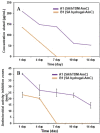Human Treated Dentin Matrix Hydrogel as a Drug Delivery Scaffold for Regenerative Endodontics
- PMID: 36703697
- PMCID: PMC9868998
- DOI: 10.22037/iej.v17i4.35580
Human Treated Dentin Matrix Hydrogel as a Drug Delivery Scaffold for Regenerative Endodontics
Abstract
Introduction: The objective of the current study was to develop a human treated dentin matrix (hTDM) hydrogel for use as a scaffold to allow the controlled release of an antimicrobial agent for regenerative endodontics.
Materials and methods: Human extracted teeth were treated via chemical demineralization using ethylene diamine tetra-acetic acid solution to produce hTDM powder. Fourier transform infrared spectroscopy (FTIR) was conducted to determine the functional groups of hTDM, scanning electron microscopy (SEM) was used to define the morphology/particle size of hTDM, and energy dispersive X-ray analysis was performed to identify the superficial apatite groups. Prepared hTDM powder was added to the amoxicillin-clavulanate mixture with a mass ratio of 1:1. Then, the combination was dripped into a 5% (w/v) calcium chloride solution. Antibiotic release profiles were evaluated for 14 days via high performance liquid chromatography (HPLC). Hydrogel degradation properties were studied for 14 days using 10 mL of phosphate buffered saline (PBS). Encapsulation efficiency was determined by HPLC, while minimum inhibitory concentration (MIC) and minimum bactericidal concentration (MBC) of amoxicillin-clavulanate were determined against Enterococcus faecalis (E. faecalis). The antibacterial activity of amoxicillin-clavulanate against E. faecalis was investigated for 14 days via agar diffusion test. Statistical analysis was performed with the Shapiro-Wilk test (P=0.05).
Results: hTDM showed statistically a significant difference for percentage weight change (P=0.1). The encapsulation efficiencies for hTDM hydrogel with antibiotic and hydrogel with antibiotic was 96.08%±0.02 and 94.62%±0.11, respectively. MIC and MBC values of amoxicillin-clavulanate against E. faecalis were 2.4 µg/mL and 9.6 µg/mL, respectively. The antibacterial activity of antibiotic loaded hTDM hydrogels was significantly greater than loaded hydrogels alone by 31% after 4 days and 100% at 14 days, respectively (P≤0.001).
Conclusions: This in vitro study showed antibiotic-loaded injectable hTDM hydrogel could be an alternative system to transfer antibiotic-based intracanal medicaments for use in regenerative endodontics.
Keywords: Demineralized Dentin Matrix; Drug Delivery Systems; Hydrogels; Regenerative Endodontics.
Figures






References
-
- Silva JS, Marques-da-Silva D, Lagoa R. Towards the Development of Delivery Systems of Bioactive Compounds With Eyes Set on Pharmacokinetics. Modeling and Control of Drug Delivery Systems. Elsevier; 2021. pp. 125–144.
-
- Mueller B, Treccani L, Rezwan K. Antibacterial active open-porous hydroxyapatite/lysozyme scaffolds suitable as bone graft and depot for localized drug delivery. J. Biomater. 2017;31(8):1123–34. - PubMed
-
- Soriano-Souza CA, Rossi AL, Mavropoulos E, Hausen MA, Tanaka MN, Calasans-Maia MD, et al. Chlorhexidine-loaded hydroxyapatite microspheres as an antimicrobial delivery system and its effect on in vivo osteoconductive properties. J. Mater. Sci.: Mater. Med. 2015;26(4):166. - PubMed
LinkOut - more resources
Full Text Sources
